|

by Viola Zhou
February 21,
2020
from
InkStoneNews Website
Italian version
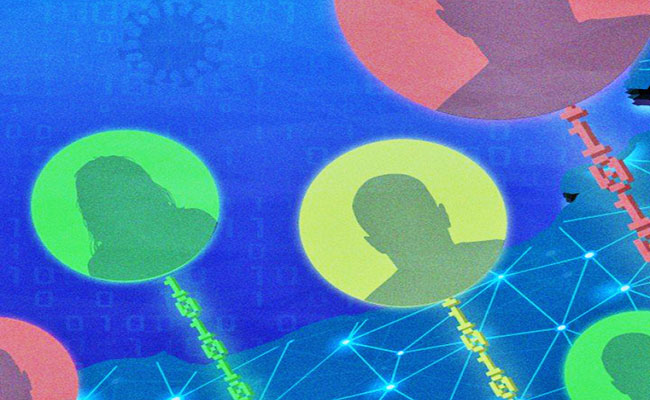
Photo: Illustration: Tom Leung
China's
Technocracy failed to keep coronavirus in the
laboratory, but now throws more technology at their
problem now that it is at epidemic levels:
namely, surveillance plus AI to automate and
herd individual quarantine.
Source
The
Chinese government
is using the
massive amount of
data it has
collected to categorize people
according to
their likelihood of infection
by the new
coronavirus.
But some people
say
they have been
incorrectly tagged
and forced into
quarantine...
On Valentine's Day, a 36-year-old lawyer in eastern China discovered
he had been coded "red."
The lawyer, Matt Ma, was effectively put in chains.
The color, displayed
in a payment app on his smartphone, indicated that he needed to
be quarantined at home even though he was not sick.
Without a green light from the system, he could not travel from
his home village to the eastern city of Hangzhou, or make it
past the checkpoints that have sprung up across the city as a
measure to contain the new coronavirus.
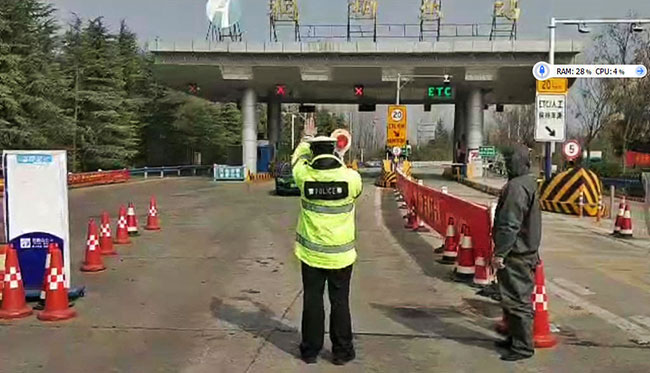
Click image to watch video...
Ma is one of the millions
of people whose movements are being choreographed by the government
through software that feeds on troves of data and spits out orders
that effectively dictate whether they must stay in or can go to
work.
Their experience represents a slice of China's desperate attempt to
stop a devastating contagion using a mixed bag of cutting-edge
technologies and old-fashioned surveillance.
It was also a rare
real-world test of the use of technology at a large scale to halt
the spread of communicable diseases.
"This kind of massive
use of technology is unprecedented," said Christos Lynteris, a
medical anthropologist at the University of St Andrews who has
studied epidemics in China.
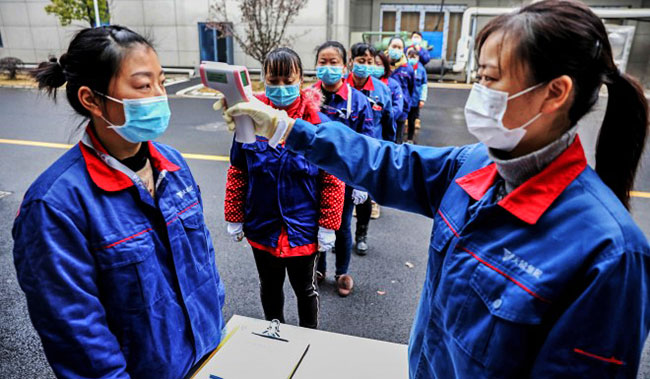
Employees undergo temperature checks
at a company in Huzhou, Zhejiang province on February 12.
Chinese officials fear that migrant workers
returning from an extended Lunar New Year holiday
could cause another wave of
coronavirus infections.
But Hangzhou's experiment has also revealed the pitfalls of applying
opaque formulas on a large population.
In the city's case, there are reports of people being marked
incorrectly, falling victim to an algorithm that is, by the
government's own admission, not perfect.
Red alert
The rating system that snagged Ma is known as Health Code and can be
accessed through the Alipay payment app.
It was developed by
Ant Financial, an affiliate of
e-commerce giant Alibaba, and local authorities of Hangzhou,
home to many of China's biggest tech companies. (Alibaba also owns
Inkstone.)
It was launched last week as millions of Chinese people began
returning to work after a Lunar New Year holiday that was extended
by the coronavirus epidemic.
The color code is the result of an automated analysis that
uses what Chinese officials have called "big data" to identify
potential carriers of the coronavirus as the country gets back to
work.
Chinese official state media has reported that the system covers
three provinces:
...and the
municipality of Chongqing with a
total population of nearly 180 million, and will soon cover
the entire country.
In Hangzhou, where the system was first launched, the city's deputy
Communist Party chief Zhang Zhongcan said the software takes
into consideration one's self-declared health status, travel history
and the people they have been in close contact with.
The city has assigned every resident one of three colors:
green, yellow and
red,
...indicating different
levels of risk the person poses to public health.
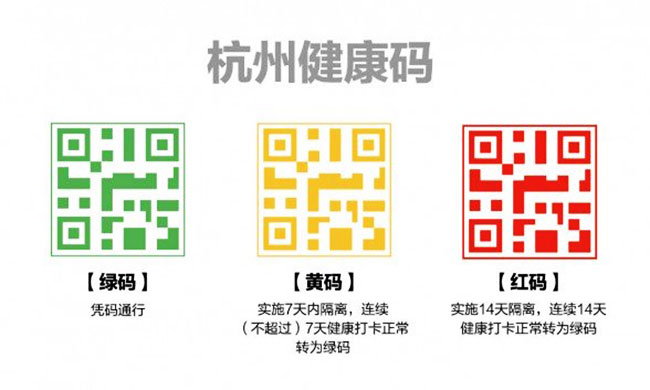
The health code system in Hangzhou
has
assigned every resident one of three colors,
indicating different levels of risk
the
person poses to public health.
Photo:
Weibo
People with QR codes
colored in red are not allowed to enter public
venues such as subway stations, restaurants and shopping malls
for at least 14 days. Workers at those places are able to scan
the QR code to verify the users' identity.
Yellow
code holders face similar restrictions, but for seven days.
Among the 7.6 million Hangzhou residents who had obtained the
digital health certification by February 17, 93% were marked "green,"
while 4%, or about 335,000 people, got the red code.
Not everyone is happy
with the ratings they got.
On China's Twitter-like
Weibo, many holders of the red tag have complained that they don't
know why they have been rated as high risk and prevented from going
out.
Some said their code turned red after they ticked "stuffy nose" or
"fatigue" on the system's health declaration form, even though the
symptoms are common and could have nothing to do with the
coronavirus.
The online critics have compared the color codes to "certificates of
good conduct" or a "caste system."
I felt I was
at the mercy of
big data...
Matt Ma
Hangzhou
resident
Authorities have admitted that "some" ratings are not accurate,
without saying how many.
On February 12, a man was
pulled off a Hangzhou-bound plane in the northeastern city of
Harbin due to his red tag -
he took the same flight with a coronavirus patient on January 15 but
never developed symptoms.
Two days later, police manually changed his rating from "red" to
"green," according to a report by the Qianjiang Evening News.
The authorities and
Ant Financial have not detailed how
the data are collected and calculated in the Health Code system.
A spokesperson for Ant
Financial said questions about data protection and accuracy
should be answered by the government, which provides the health code
service and operates the system.
Back to work
Officials need to get people back to their jobs to restart an
economy threatened by the epidemic.
Even before the outbreak,
the Chinese economy grew at its slowest pace in 29 years, and
disruption to businesses caused by the virus could set it back
further.
But the authorities also fear the returning workers could cause
another wave of infections in the crowded cities.
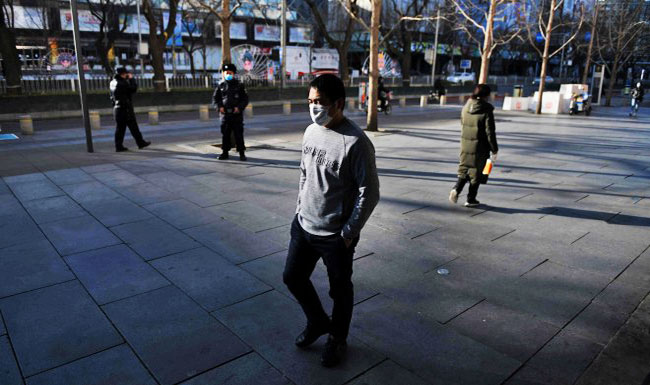
A man wearing a protective mask
walks in a deserted shopping area
in Beijing on February 17.
Photo: AFP
Ma, who spent the Lunar New Year holiday in his hometown in
Lishui, Zhejiang province, was required to obtain the code before
traveling to Hangzhou.
He filled in a form
about his health condition and travel history, and the system
returned with a red QR code.
Having been nowhere near
the center of the outbreak, the central province of Hubei where the
overwhelming majority of infections and deaths have been reported,
Ma wanted to contest his status.
But when he called a
government helpline, he only got an automatic answer.
"I felt I was at the
mercy of big data," Ma told Inkstone on February 19.
"I couldn't go
anywhere. There's no one I could turn to for help, except answer
bots."
In a mysterious turn, his
code changed from red to green two days later.
The entire process was
puzzling, he said...
A lawyer specializing on data compliance, Ma said the system could
violate Chinese law if citizens are put under travel bans by
machines without being given a chance to appeal.
A man named James, who works at a property company in
Hangzhou, said he might have been tagged red because he spent the
Lunar New Year in a smaller city hit hard by the virus.
But the 26-year-old, who declined to be named, doesn't believe the
red code is justified, since he had stayed home and had not
interacted with strangers in the past three weeks.
This week, James joined two WeChat messaging groups with
about 200 other people, all red code holders, to brainstorm ways to
return to work in Hangzhou.
He said he might resort to borrowing another person's national ID
card and account on Alipay in order to pass the highway checkpoints.
"I would be wearing a
mask, and hopefully the officers wouldn't spot it," he said.

A family
wearing masks and makeshift protection gear
at the Hongqiao high speed rail station
in Shanghai on February 11.
Photo: Bloomberg/Qilai Shen
'A magical belief'
In China, authorities are able to collect massive data through its
extensive surveillance network, which includes,
-
ubiquitous
security cameras
-
real-name
registration for internet users
-
train passengers
and facial scans at hotel check-in counters
The Chinese government
has previously praised the use of "big data," including its medical
applications, as a crucial tool to help it govern better.
Throughout the crisis, authorities have used data to track where
infected patients have been, identify their close contacts and look
for people who have traveled out of the outbreak's epicenter.
Those picked out by software are then passed on to a surveillance
and enforcement network - millions of community workers who would
put them under quarantine, check their body temperatures every day
and, in extreme cases, use metal chains to lock them up at home.
On February 16, a Hangzhou official acknowledged at a press
conference criticism of the health code system from those contesting
their ratings.
He said the
government had sent workers to verify the data, adding that the
algorithm would be modified to enhance accuracy.
Despite the glitches,
officials are already boasting about the contribution of its
"abundant data resources" in containing the epidemic, which has
infected more than 75,000 and killed at least 2,239 in China.
Besides health code, a series of other digital tools, powered by
data, have also been deployed to screen out people deemed high risk
and restrict their movements.
A state-run platform called "close contact detector" now allows
employers to check if their workers have been in close contact with
confirmed or suspected coronavirus patients in the past 14 days by
inputting the employees' national ID numbers.

Several million community workers
have been deployed to carry out
epidemic control measures.
Photo: Xinhua/Xiao Yijiu
China's state-run telecom operators have also provided data on
users' movements to local officials.
In the eastern city of
Wenzhou, for example, officials
earlier this month identified 3,615 people who came close to a rice
noodle shop after two shop owners fell ill, with data provided by
mobile operators.
Community officers later called all of them and put 40 people who
claimed to have visited the shop under quarantine.
On the Chinese Internet, opinions about the use of big data are
divided.
Some people say the
powerful technologies are making them feel safer, but others
have raised concerns of mislabeling and privacy violations.
Maya Wang, a
senior China researcher with Human Rights Watch, said the
government's existing surveillance infrastructure, built to crack
down on crime, is increasingly being used to regulate other aspects
of people's life, including tracking their health status.
"In China it's
particularly problematic because there is not only no law on the
practice of surveillance and there's almost no mechanism to
challenge the mass surveillance," she said, citing the lack of
freedom of expression and an independent judiciary.
Some previous attempts
made by tech companies to trace viruses with big data have failed.
Google Flu Trends, which
promised to monitor flu cases based on Google searches, was shut
down in 2015 after it was found to be consistently overestimating
cases in the US.
People have
a magical belief
in technology...
Christos
Lynteris
University of St
Andrews
Christos Lynteris, of the University of St Andrews, said it's
difficult to tell whether China's surveillance efforts have helped
with disease control or not if the government does not allow
transparent, scientific studies.
Applying flawed technologies risks putting the wrong people under
quarantine, strengthening the stigma of infected population and
wasting the already-strained resources in epidemic control, he says.
But regardless of the effect of the technology-driven campaign's
effectiveness, Lynteris says it gives people living in the crisis a
sense of hope.
"People have a
'magical belief' in technology," he said.
"This public
spectacle of a digital technology being deployed does create a
sort of public consent which is much needed on the ground.
Technology is
reassuring the public the epidemic will be 'resolved'."
|








